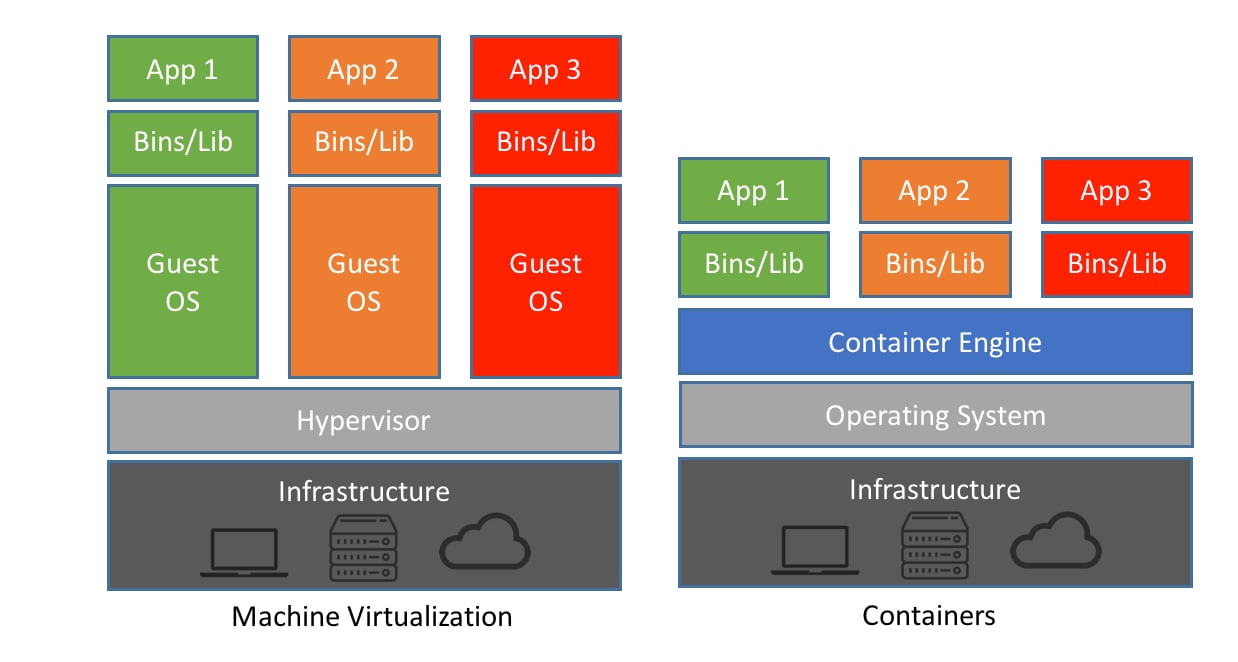Containers vs. Virtual Machines (VMs): What's the Difference?


Doug Jones
- How do they differ from virtual machines?
- If containers are, by their nature, transitory and disposable, how can you use them alongside persistent storage?
- How do they complement existing virtualization and orchestration solutions?
Within each virtual machine runs a unique guest operating system. VMs with different operating systems can run on the same physical server—a UNIX VM can sit alongside a Linux VM, and so on. Each VM has its own binaries, libraries, and applications that it services, and the VM may be many gigabytes in size.
 Server virtualization provided a variety of benefits, one of the biggest being the ability to consolidate applications onto a single system. Gone were the days of a single application running on a single server. Virtualization ushered in cost savings through reduced footprint, faster server provisioning, and improved disaster recovery (DR), because the DR site hardware no longer had to mirror the primary data center.
Server virtualization provided a variety of benefits, one of the biggest being the ability to consolidate applications onto a single system. Gone were the days of a single application running on a single server. Virtualization ushered in cost savings through reduced footprint, faster server provisioning, and improved disaster recovery (DR), because the DR site hardware no longer had to mirror the primary data center.
Development also benefited from this physical consolidation because greater utilization on larger, faster servers freed up subsequently unused servers to be repurposed for QA, development, or lab gear. But this approach has had its drawbacks. Each VM includes a separate operating system image, which adds overhead in memory and storage footprint. As it turns out, this issue adds complexity to all stages of a software development lifecycle—from development and test to production and disaster recovery. This approach also severely limits the portability of applications between public clouds, private clouds, and traditional data centers. What Are Containers? Operating system (OS) virtualization has grown in popularity over the last decade to enable software to run predictably and well when moved from one server environment to another. But containers provide a way to run these isolated systems on a single server or host OS.
Containers sit on top of a physical server and its host OS—for example, Linux or Windows. Each container shares the host OS kernel and, usually, the binaries and libraries, too. Shared components are read-only. Containers are thus exceptionally “light”—they are only megabytes in size and take just seconds to start, versus gigabytes and minutes for a VM.
Containers also reduce management overhead. Because they share a common operating system, only a single operating system needs care and feeding for bug fixes, patches, and so on. This concept is similar to what we experience with hypervisor hosts: fewer management points but slightly higher fault domain. In short, containers are lighter weight and more portable than VMs. Conclusion Virtual machines and containers differ in several ways, but the primary difference is that containers provide a way to virtualize an OS so that multiple workloads can run on a single OS instance. With VMs, the hardware is being virtualized to run multiple OS instances. Containers’ speed, agility, and portability make them yet another tool to help streamline software development.
At NetApp®, we believe in container technology and are working to deliver innovations that promote even more speed and agility in software development. We’ve developed Trident with the goal of making persistent storage automatic and seamless. Check out our latest release of Trident on GitHub, and also on our container solutions page. For more information, or if you have questions, check out thePub at netapp.io.
Doug Jones
Doug Jones is a senior product services manager with NetApp and leads portfolio strategy for Migration Services. He holds an MBA from Duke Fuqua School Business in General Management and a Bachelor’s in Computer Science from Florida Atlantic University. He lives in the greater Asheville, NC area.